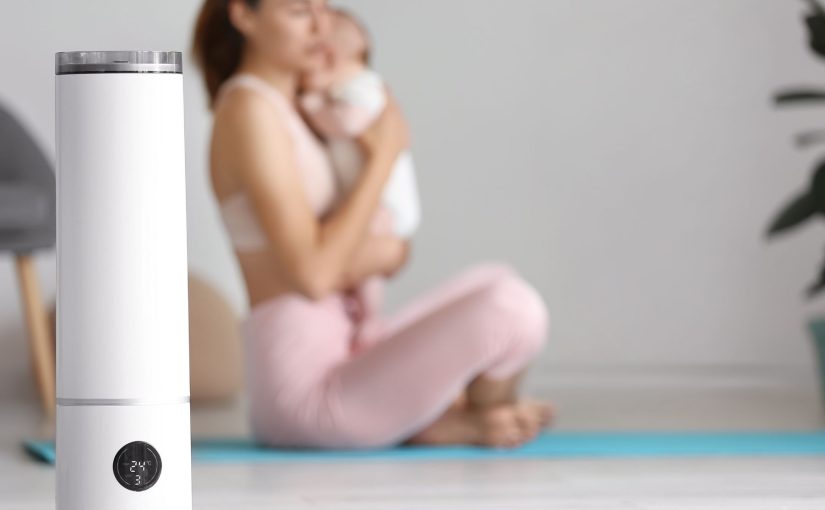Table of Contents
Can a Humidifier Help With Snoring in Infants?
Yes, using a cool mist humidifier can potentially help relieve mild infant snoring that is caused by dry air or nasal congestion. The added moisture provided by a humidifier helps keep nasal passages and throat tissues lubricated, allowing easier breathing.
| Quick Facts on Infant Snoring and Humidifiers |
| – Snoring is common in babies due to narrow nasal passages and throat tissues |
| – Dry air can irritate nasal passages, causing congestion and snoring |
| – Cool mist humidifiers add moisture back into the air to ease breathing |
| – Ideal to use during winter months when heat causes dry air |
| – Monitor humidity level to keep between 30-50% |
Snoring in infants is very common, especially in newborns. Their nasal passages and throat tissues tend to be narrower than in older children and adults. This can cause some vibration of the tissues and result in that familiar snoring sound. It often improves as the infant gets older and the throat and nasal anatomy mature and widen.
While most infant snoring is harmless, conditions like sleep apnea can also cause snoring and require medical treatment. It’s a good idea to mention any loud or excessive snoring to your pediatrician. But for mild snoring, using a humidifier is one approach parents can take to help keep nasal congestion at bay and potentially reduce snoring.
What Causes Snoring in Infants?
There are a few key factors that cause snoring in babies and young toddlers:
Narrow nasal passages and throat
The throat and nasal structures of infants are much smaller and narrower than in older children and adults. This means there is less space for air to flow, which can cause turbulence and snoring. Their tonsils and adenoids are also relatively larger compared to the passage size.
Congestion
Stuffy noses from colds, allergies, or dry air will restrict airflow even more. This inflammation causes the nasal tissues to vibrate against each other and generate snoring sounds.
Sleep position
Infants who sleep on their back are more likely to snore. In this position, the tongue can fall to the back of the mouth and partially obstruct breathing. Sleeping on the side or stomach allows clearer airflow. But sleeping on the back is still recommended to prevent SIDS.
Enlarged tonsils/adenoids
Some babies are born with or develop abnormally large tonsils and adenoids in relation to the size of their throat. These glands can partially block airflow in the throat and increase snoring.
Genetic factors
Facial structure and the size of nasal and throat anatomy is largely determined by genetics. Babies born with narrower airways are more predisposed to snoring issues. These features often improve with age.
So in most cases, infant snoring is caused by some degree of congestion combined with narrow nasal passages or throat. Using a humidifier is one approach to potentially relieve congestion and make breathing a bit easier.
How Do Humidifiers Help With Snoring?
Humidifiers essentially add moisture back into the air in a room. This helps reduce congestion, lubricate the nasal passages and throat, and create easier breathing. Here’s how they provide relief:
Improves congestion
Dry air causes irritation and inflammation in the nasal cavities. This swelling blocks airflow, increases snoring and congestion, and even causes nosebleeds in some cases. Adding humidity eases these symptoms.
Thins mucus
The moisture provides hydration and thins out thick nasal secretions and mucus. Thinner discharge can flow better and reduces blockages and snoring.
Soothes throat tissue
The additional humidity keeps throat tissues from drying out. Well lubricated tissues vibrate less, allowing smoother airflow and less snoring.
So for infants prone to congestion and snoring, humidifiers can be a helpful tool, especially during the dry winter months. Models that produce cool mist are the safest to use around babies.
What Type of Humidifier is Best for Infants?
There are a few types of humidifiers to choose from, each with their pros and cons. Here’s an overview of different models:
| Type | How It Works | Safety for Infants |
| Warm Mist | Heats water to steam | Risk of burns. Not recommended. |
| Cool Mist | Room temperature mist | Safest option for infants |
| Ultrasonic | High frequency vibration | Can produce white dust |
| Evaporative | Filter absorbs and releases water | No potential for burns |
For safety around infants and children, cool mist humidifiers are the best choice. Models like evaporative or ultrasonic humidifiers utilize cool water and avoid the risk of burns from heated steam vapors. Here’s how the main types compare:
Warm mist humidifiers heat water into a hot steam vapor that is released into the room. The increased humidity can help open congestion. However, the hot steam poses risks of burns, especially around small children. Warm mist models are not recommended for use in a baby’s nursery.
Cool mist humidifiers use room temperature water to produce a cool, invisible mist. This avoids any risk of burns while still increasing humidity levels. They are very safe to use around infants. Cool mist can be produced in a few ways:
- Ultrasonic humidifiers use a metal diaphragm vibrating at high frequencies to create micro-fine water droplets that quickly evaporate into the air. They produce mist silently, but may emit some harmless white dust.
- Evaporative humidifiers use a wick filter to absorb and release water vapor into the air. A fan blows air over the filter to add cool moisture. They provide soothing humidification without any noise or dust.
For any model, be sure to keep the humidifier out of reach of your baby and clean it thoroughly to prevent mold growth. Monitor the humidity level with a hygrometer and aim for 30-50%. Refill with fresh water daily and use distilled water to minimize mineral deposits. Cool mist options used properly can safely provide snoring relief for infants.
 Tips for Using a Humidifier for Infant Snoring
Tips for Using a Humidifier for Infant Snoring
Here are some best practices when using a cool mist humidifier in your baby’s room:
- Place the humidifier near an outlet on the floor at least a few feet away from crib or bassinet. This prevents direct exposure to the mist.
- Fill with cool distilled or filtered water to minimize mineral deposits that spread microbes. Change water daily.
- Clean all parts thoroughly on a regular basis as directed. Disinfect with vinegar water or hydrogen peroxide.
- Monitor with a hygrometer and aim to keep bedroom humidity between 30-50%. Too much moisture can encourage mold growth.
- Choose a model with an automatic shut off. This prevents over-humidifying if tank runs empty.
- Select a humidifier sized for the room area. A larger room needs higher mist output to reach proper humidity.
- Can use year-round to combat dry winter air or stuffy air conditioning in summer.
- Combine with saline drops before sleep to thin mucus and allow drainage. Suction congestion from nose before laying baby down.
- Allow fresh air flow by keeping door open during use. This circulates humidity and prevents excess moisture buildup.
With some care and routine cleaning, cool mist humidifiers can safely provide some snoring relief for congested infants when used properly. Make sure to keep the model out of direct reach of your baby.
When to See a Doctor for Infant Snoring
While humidifiers can help manage temporary snoring and congestion, it’s important to understand when more medical intervention is necessary. See a pediatrician or ENT doctor if your baby has any of these more severe snoring issues:
- Snoring is loud, raspy, or gasping/choking sounds
- Snoring persists for more than 1-2 weeks
- Snoring is accompanied by breathing pauses
- Color changes to blueish skin indicating lack of oxygen
- Disrupts sleep and feeding patterns or causes crankiness
- Failure to gain weight at a normal pace
These signs could indicate a medical condition like sleep apnea, enlarged adenoids, or allergies that require further treatment beyond just humidification therapy. A doctor can examine nasal and throat anatomy to see if any obstructions are causing breathing disruption and snoring.
Tests like sleep studies, CT scan or MRI can help diagnose underlying problems. Treatment may involve surgery to remove excess tissue, CPAP therapy, or medications. Seeking medical advice promptly for persistent snoring can help prevent ongoing disruptions to your baby’s breathing, sleep and development.1.
Long Term Outlook for Infant Snoring
The good news is that most mild to moderate snoring in infants and toddlers will often resolve on its own as the child gets older. There are a few reasons this disruptive snoring tends to improve with age:
- Nasal and throat anatomy widens – The nasal passages and throat expand as a child ages, leaving more room for unobstructed airflow.
- Smaller adenoids and tonsils – These lymphatic glands shrink to proportionally smaller sizes compared to the growing throat cavity.
- Maturing nervous system – Improved muscle tone in the throat keeps airway open while sleeping. The brain regulates breathing at a healthy rhythm.
- Immune system development – Strengths against common viruses means less frequent colds, reducing congestion and snoring.
While environmental factors like cigarette smoke or allergies can still cause snoring later in childhood, loud snoring past age 10 is more likely to indicate a chronic condition like sleep apnea or sinus issues.
But for most otherwise healthy infants, incorporating some humidity into the sleep environment can help ease temporary snoring and congestion during the early months and years when narrow airways contribute to noisier breathing. Consult your doctor if loud disruptive snoring persists daily or causes other concerns.
Conclusion
Using a cool mist humidifier in the baby’s room is generally safe and can potentially help relieve mild snoring caused by temporary nasal congestion and dry air. Ensure the device is out of reach and monitor humidity levels. See a doctor if loud habitual snoring persists day and night or causes breathing disruptions.
While frustrating, keep in mind that most minor snoring in infants and toddlers will typically resolve with time as their airways grow and mature. With some added moisture and proper positional sleep habits, restful quiet breathing is often achievable.

